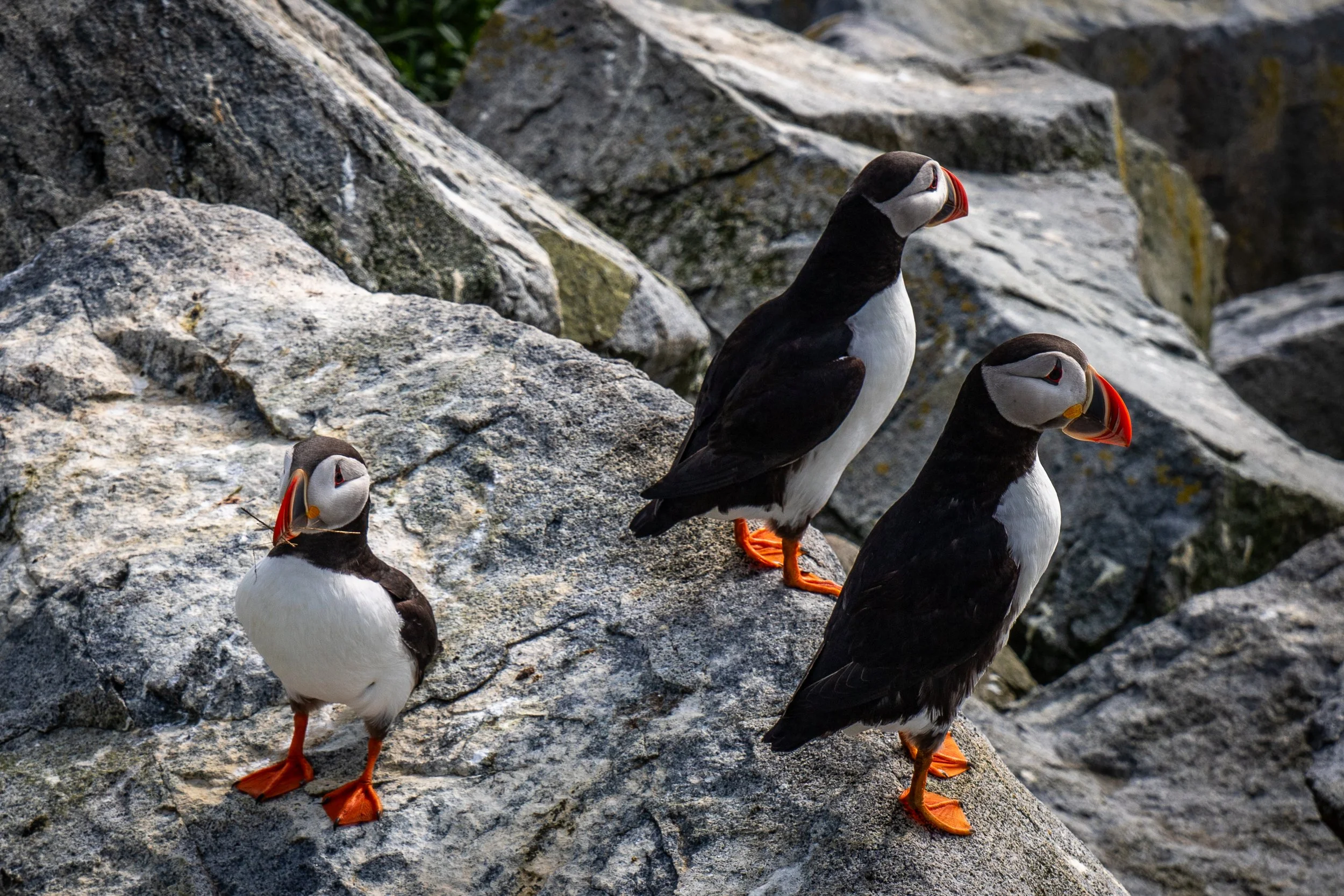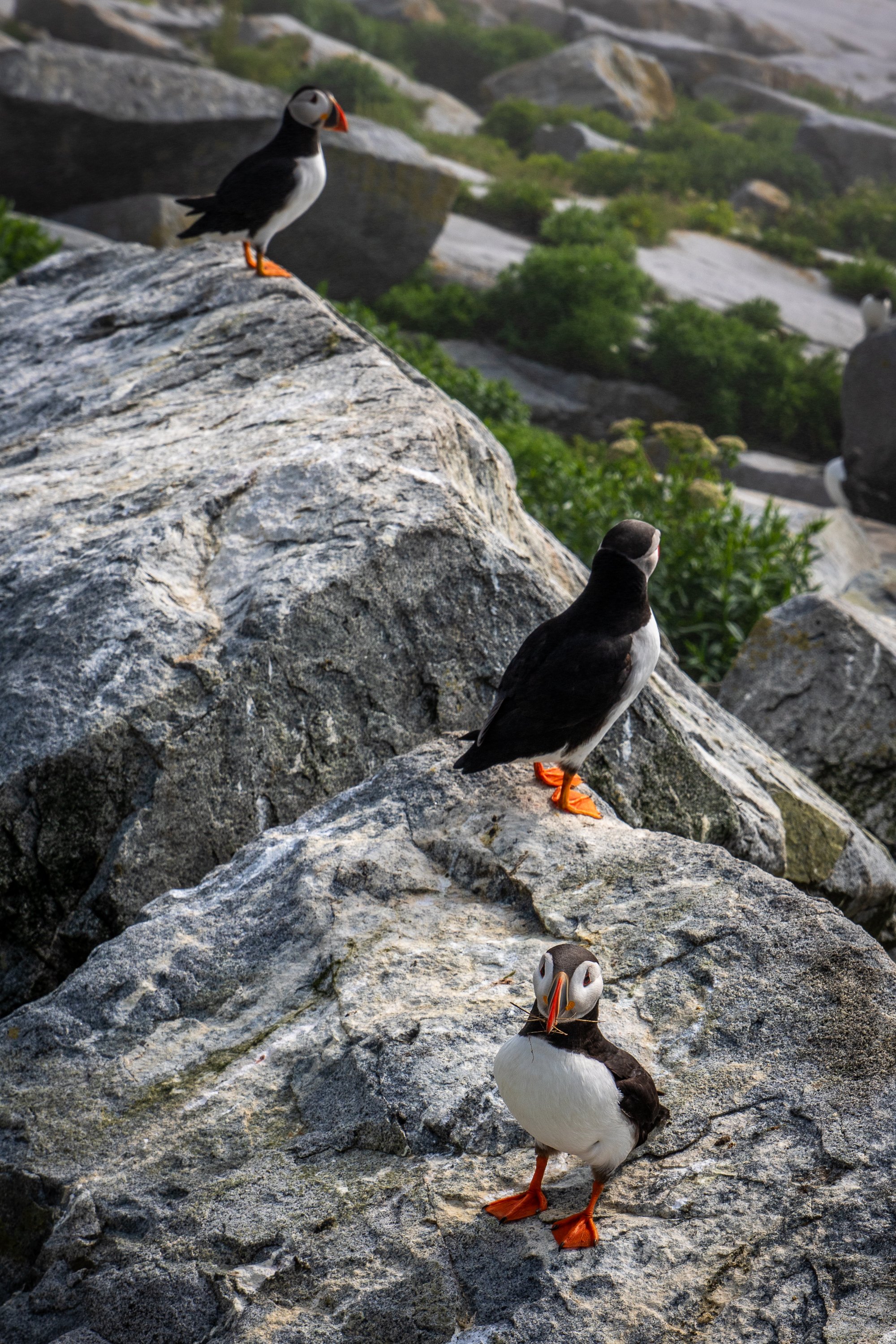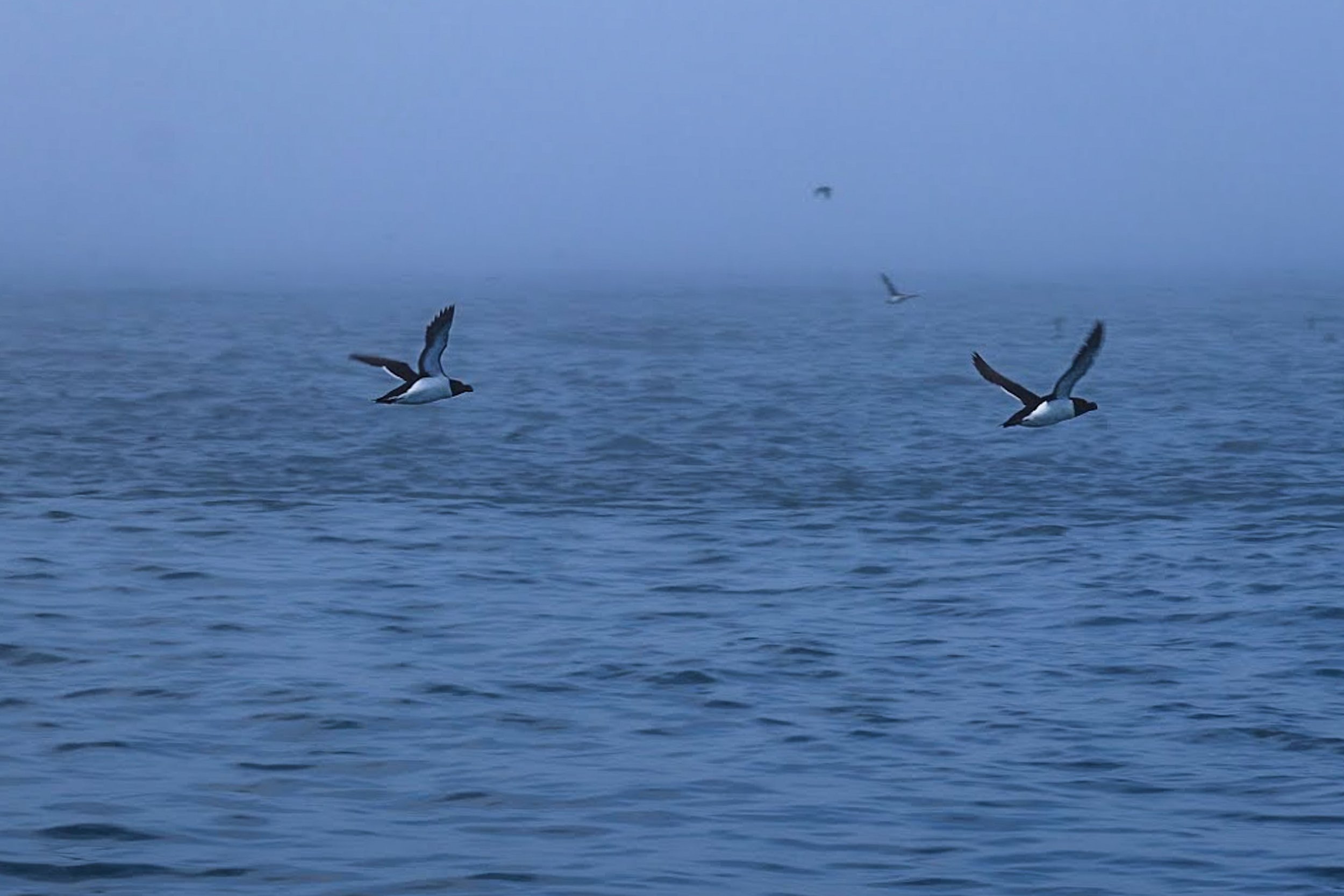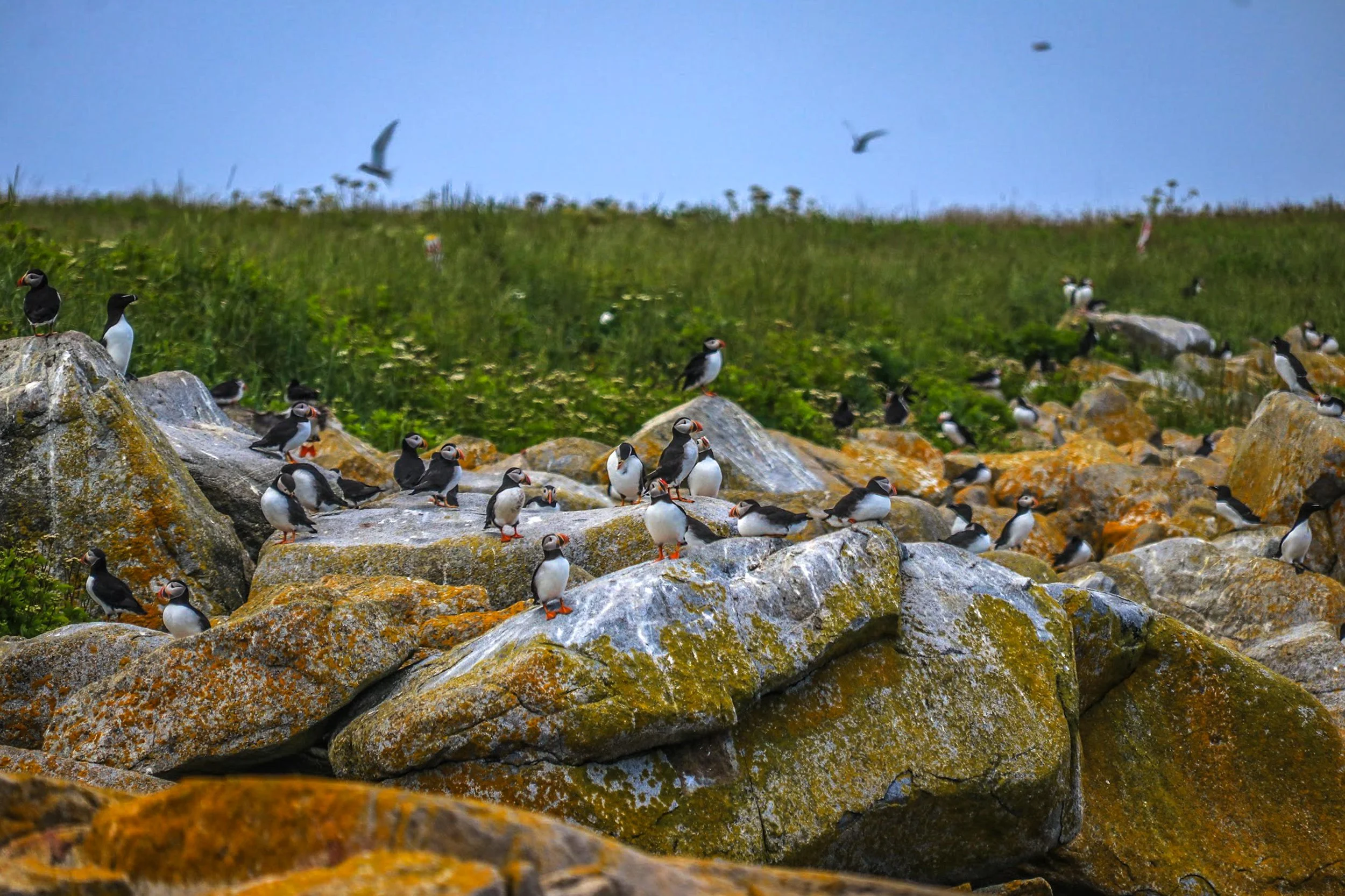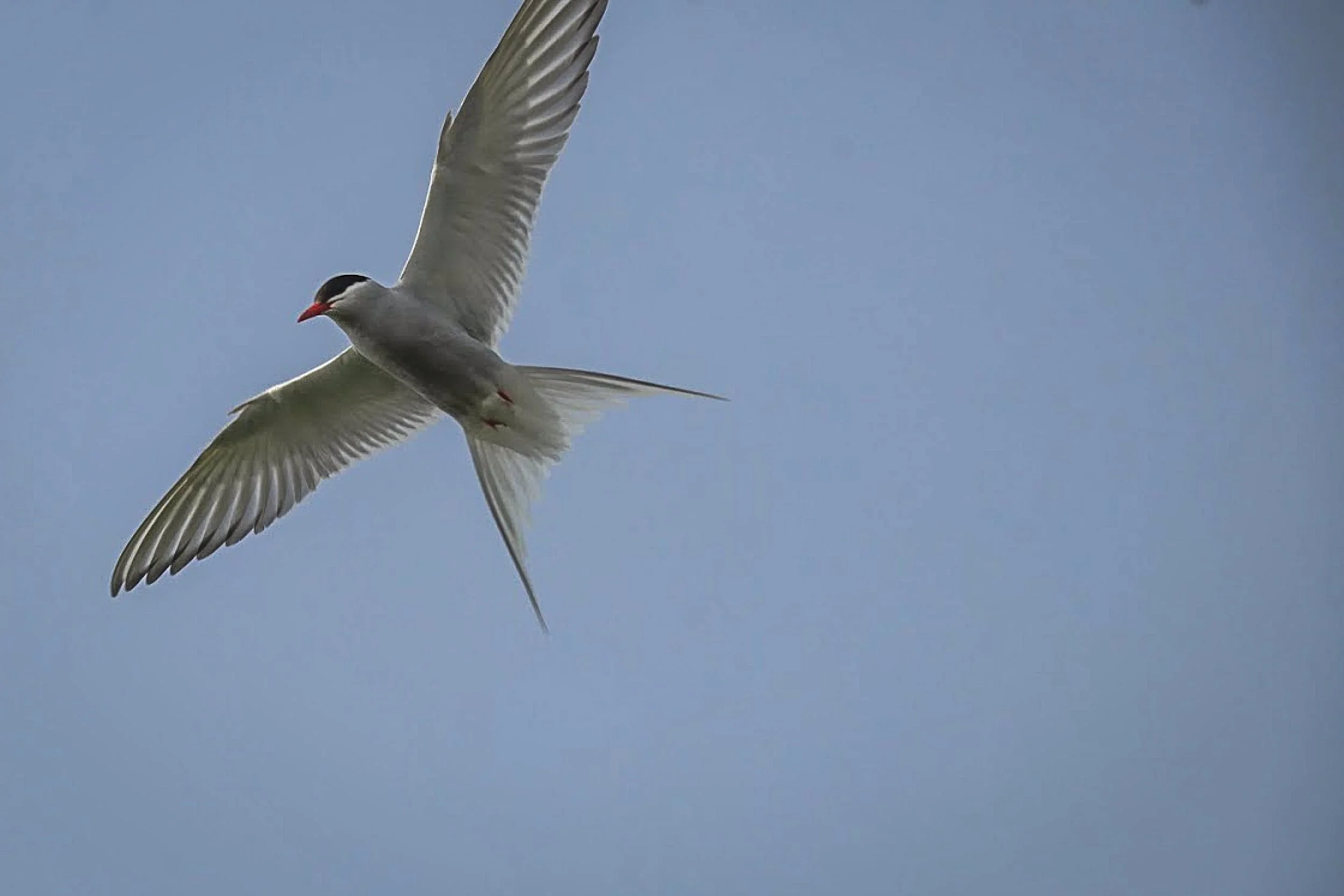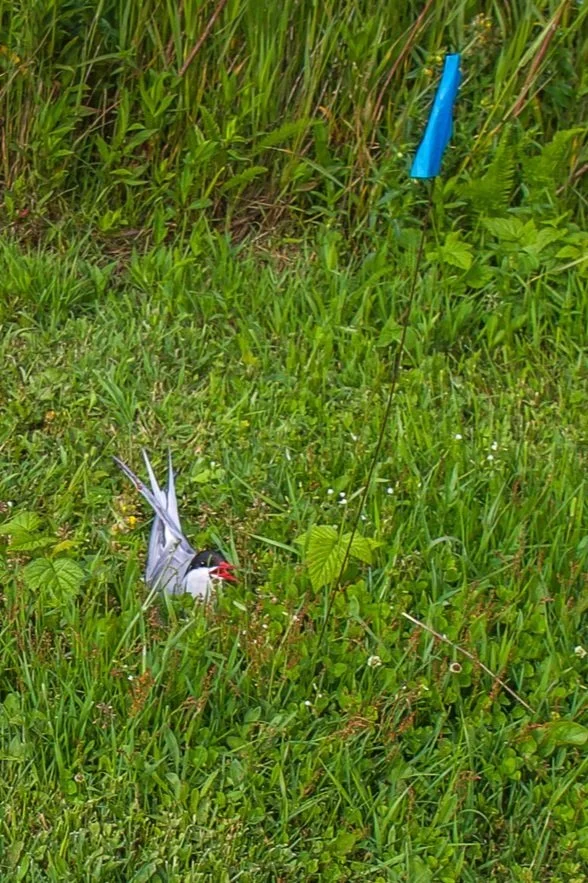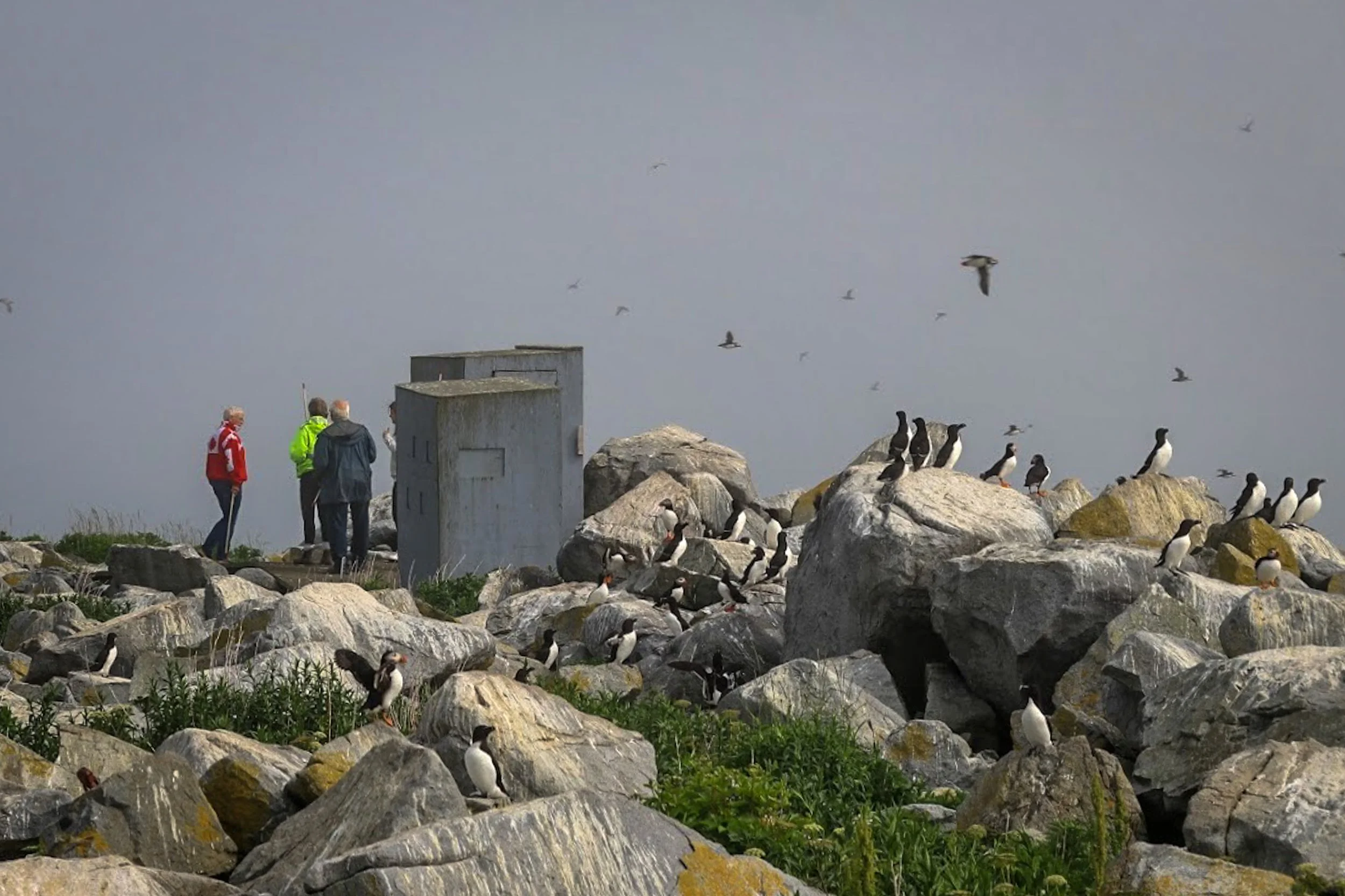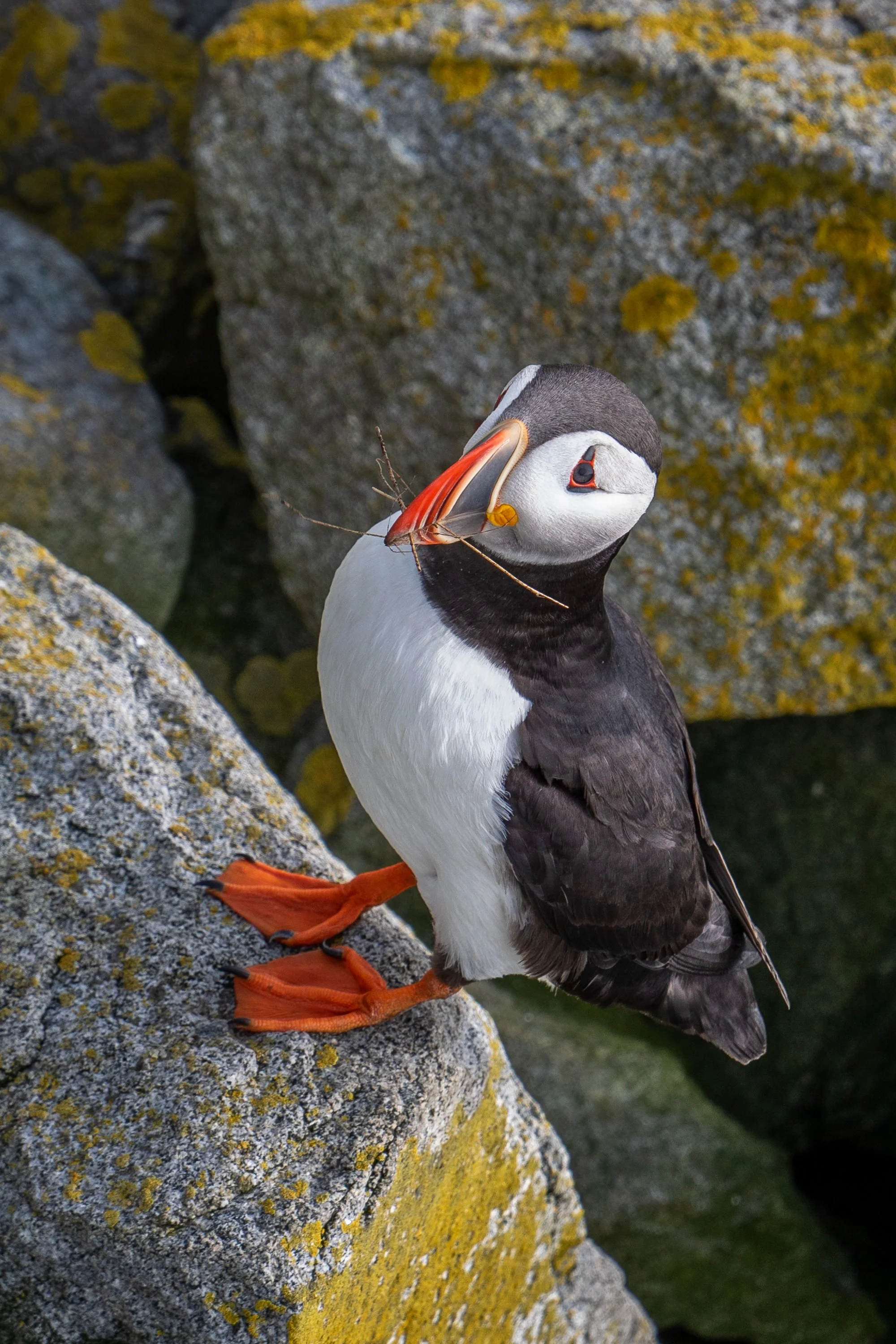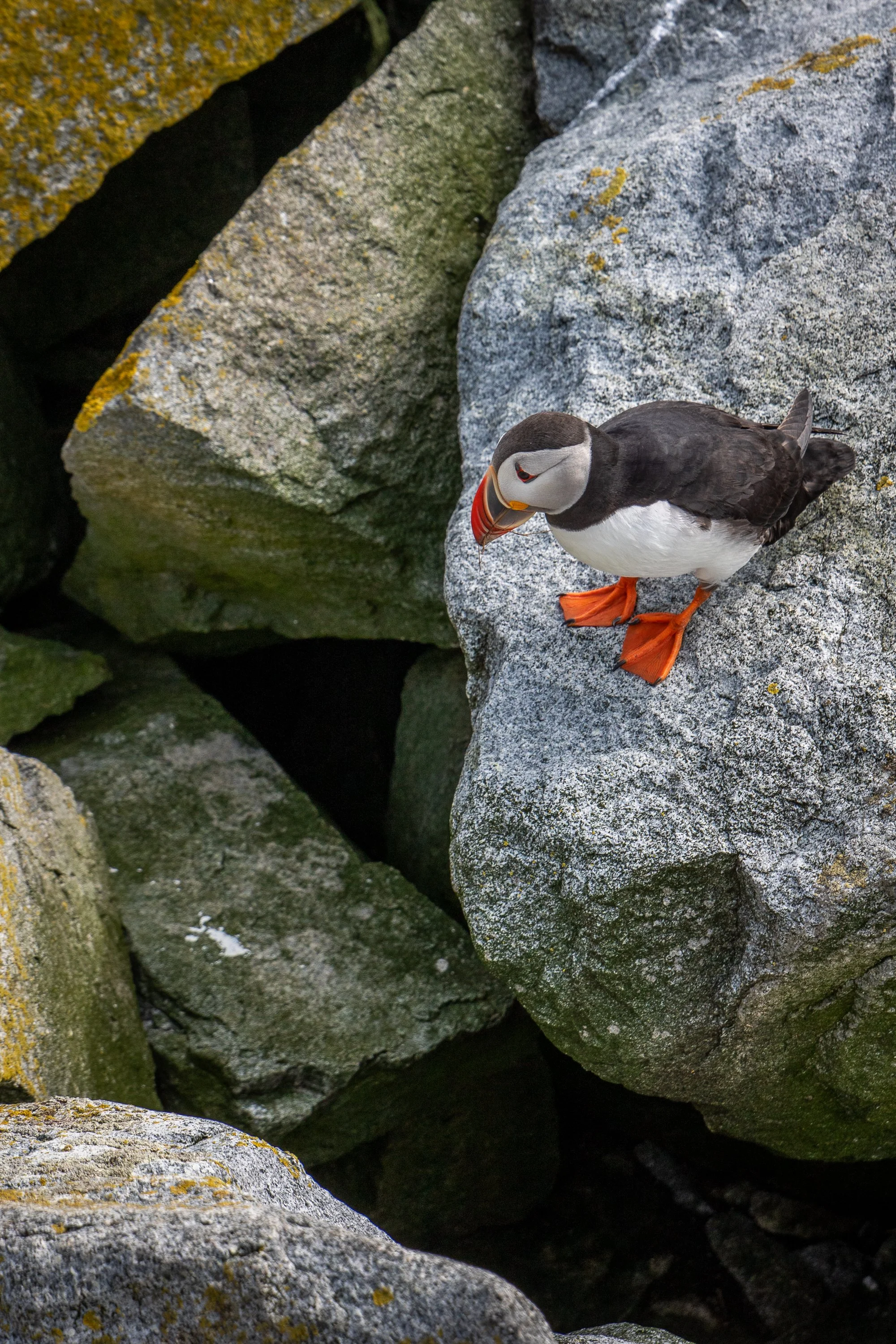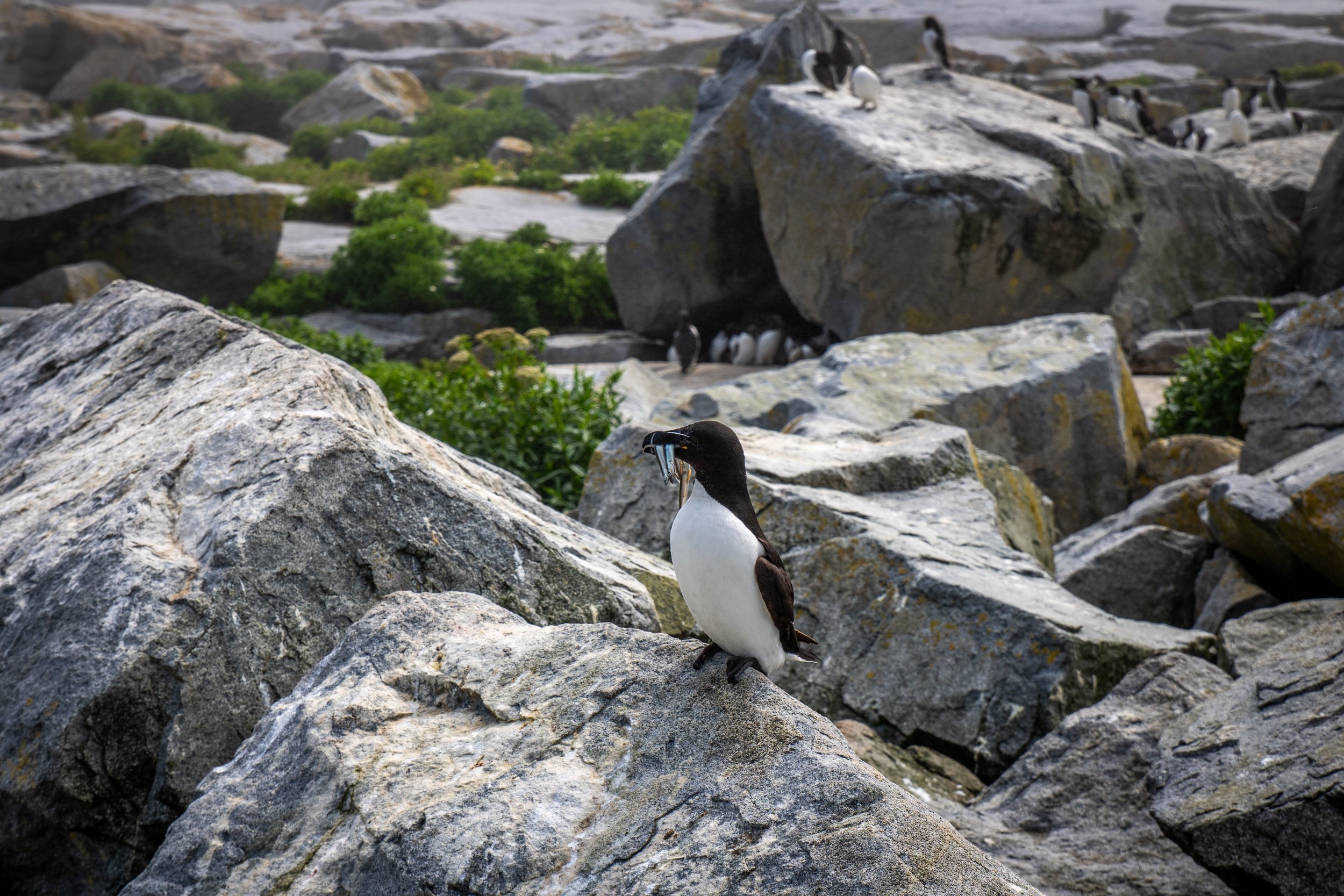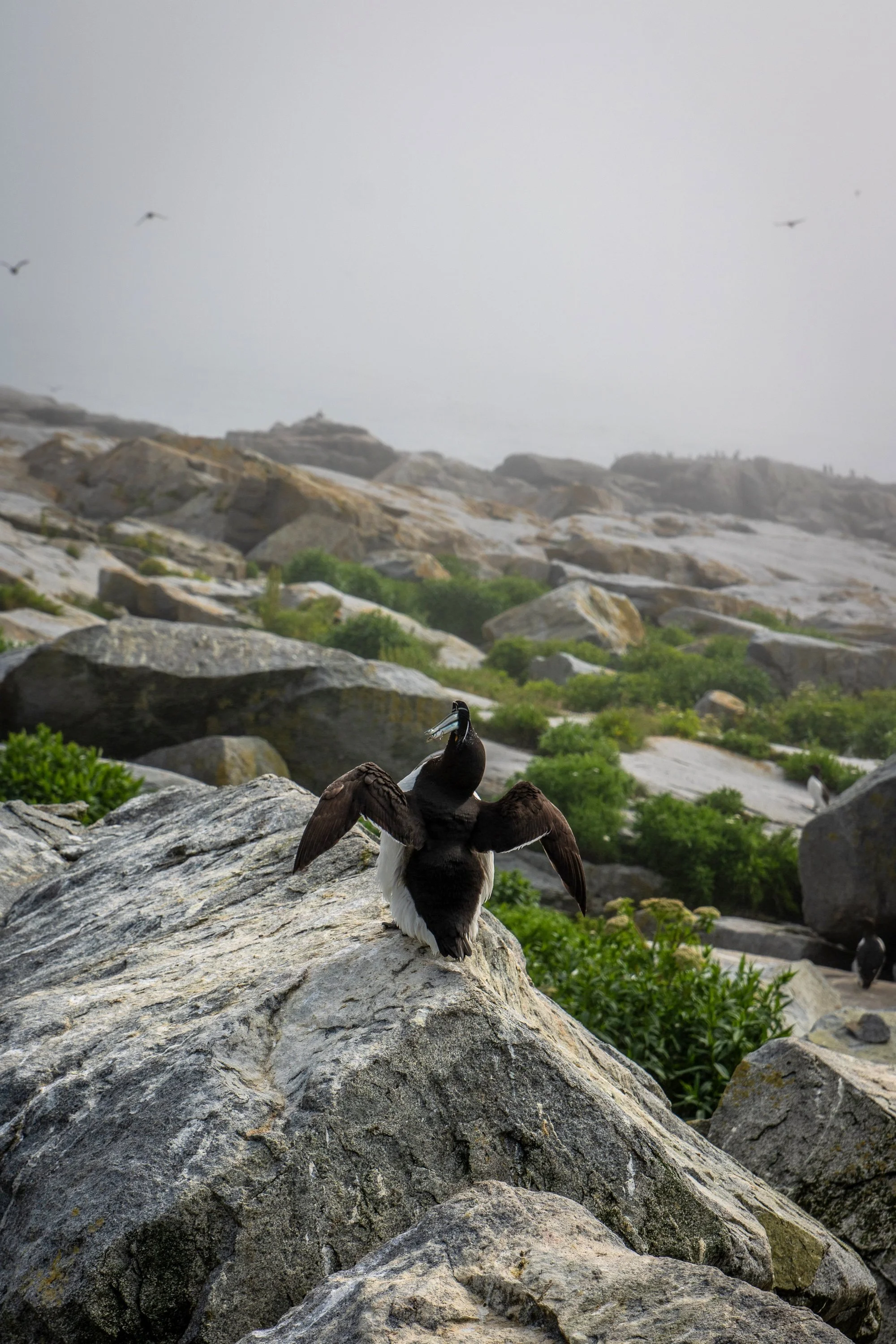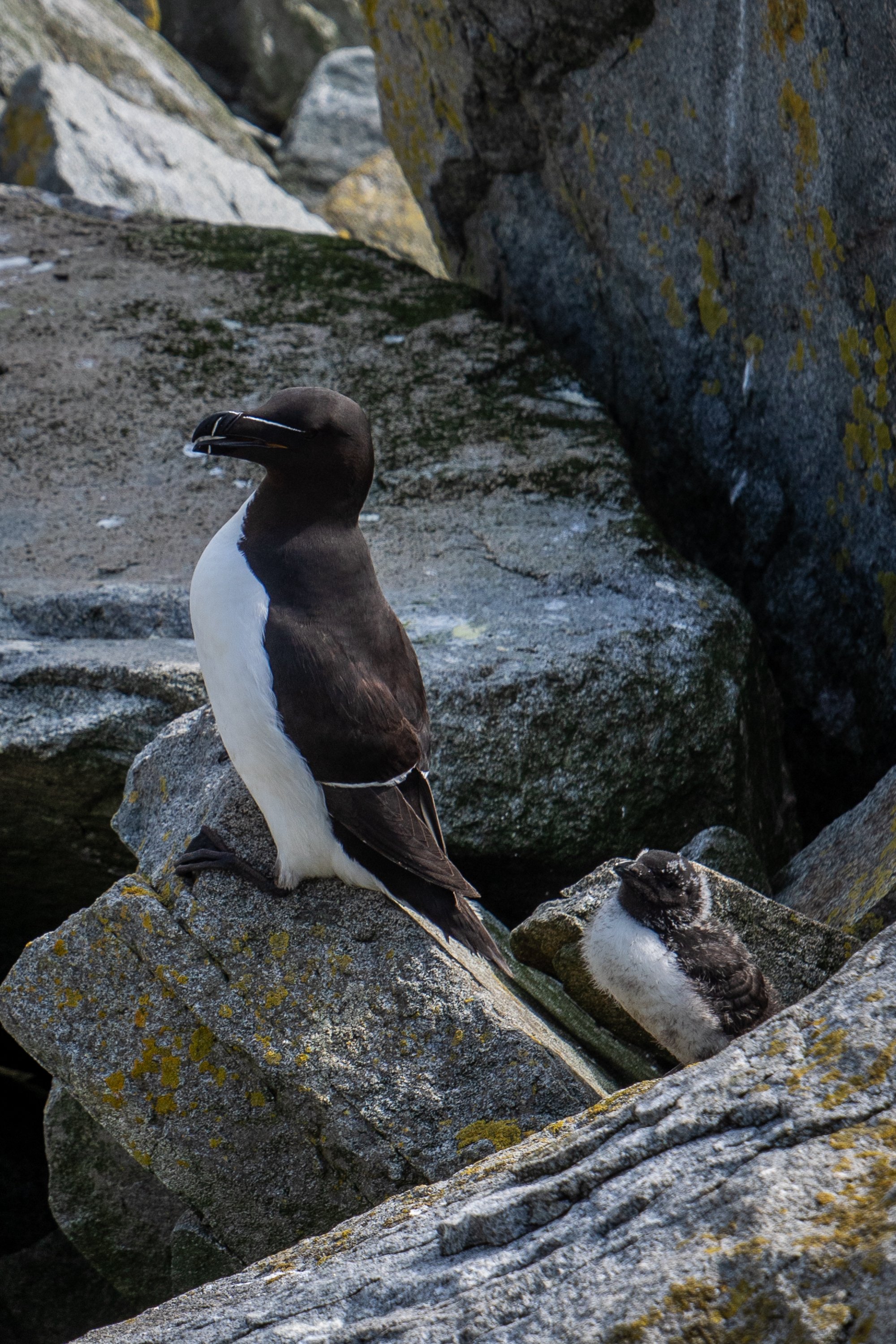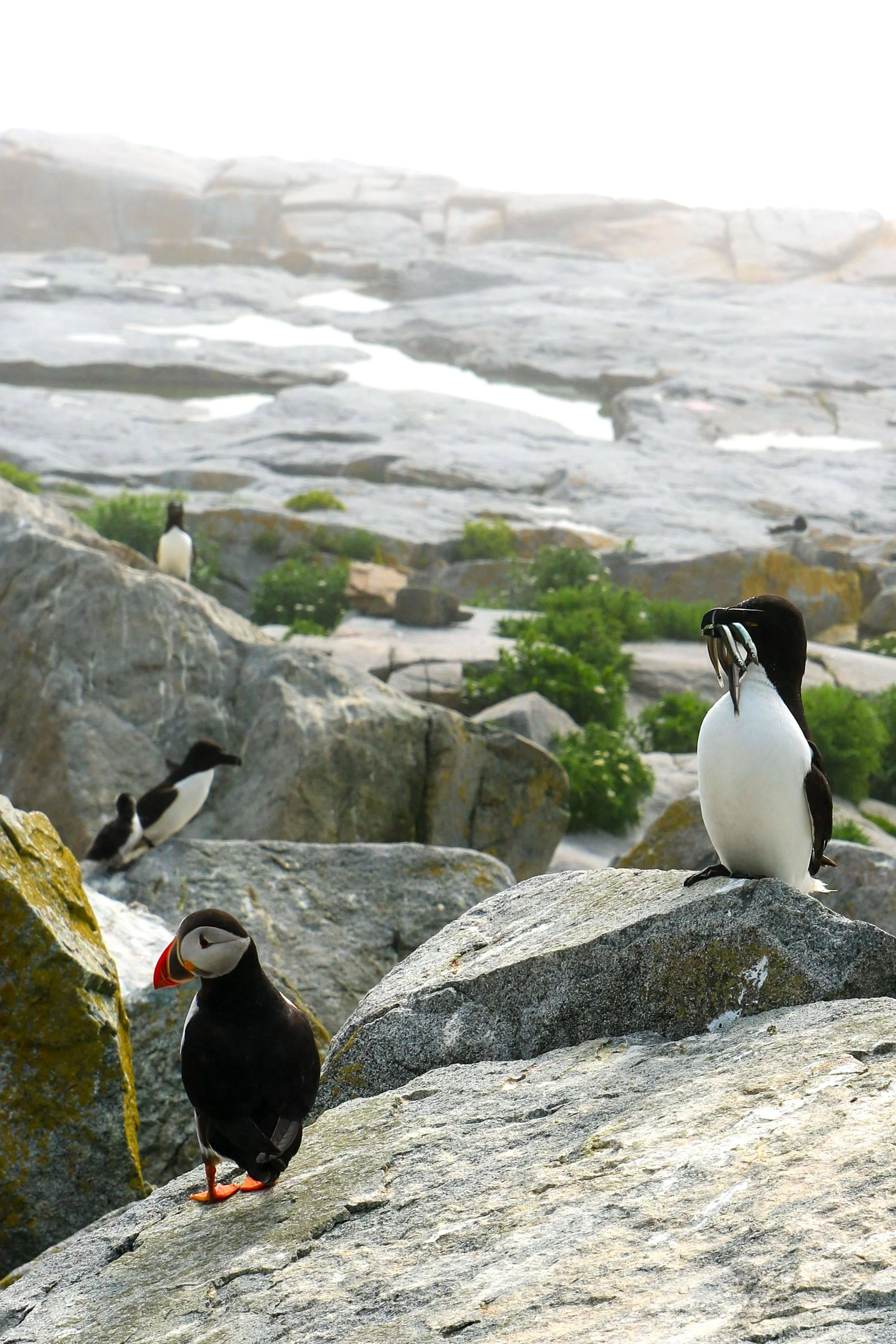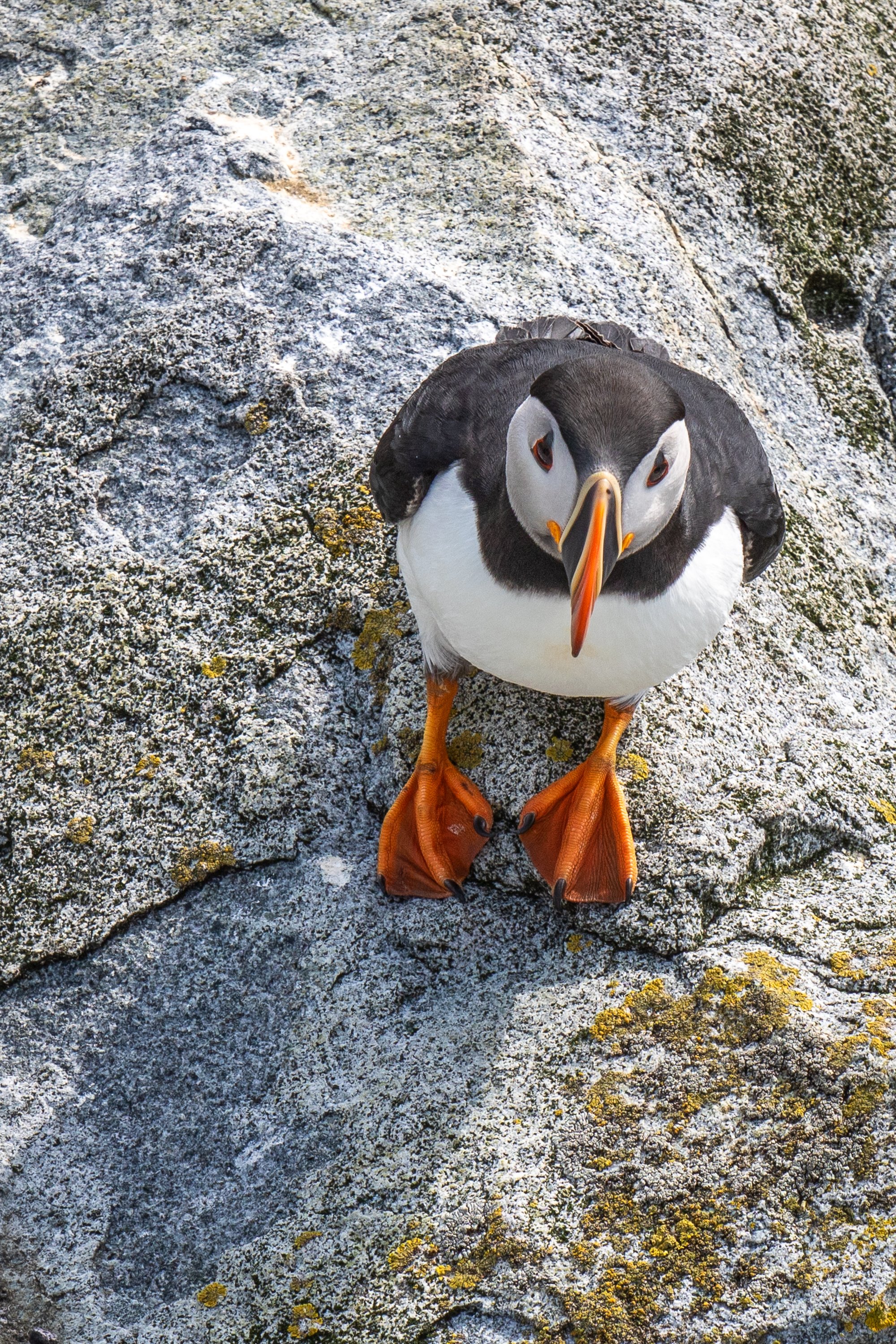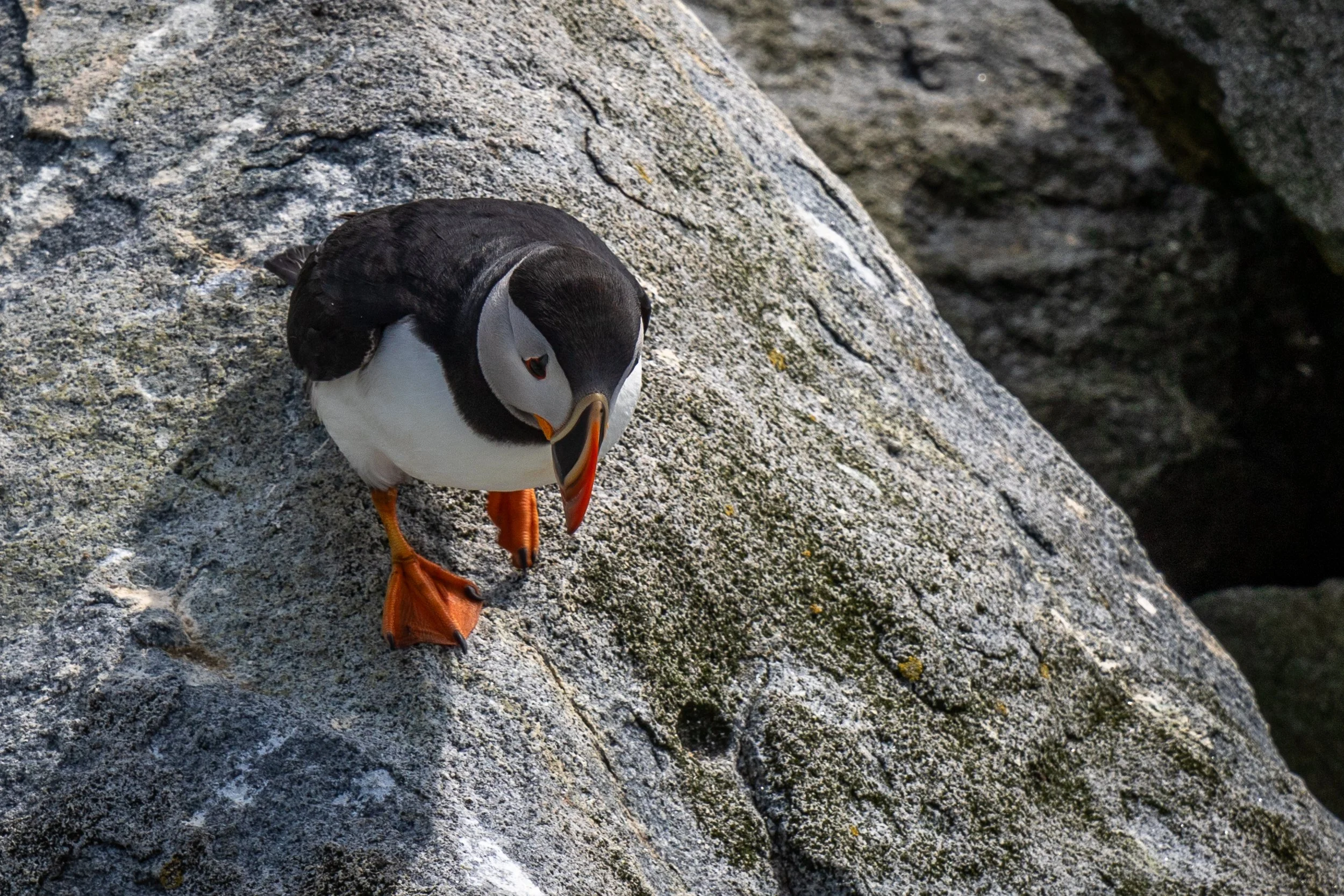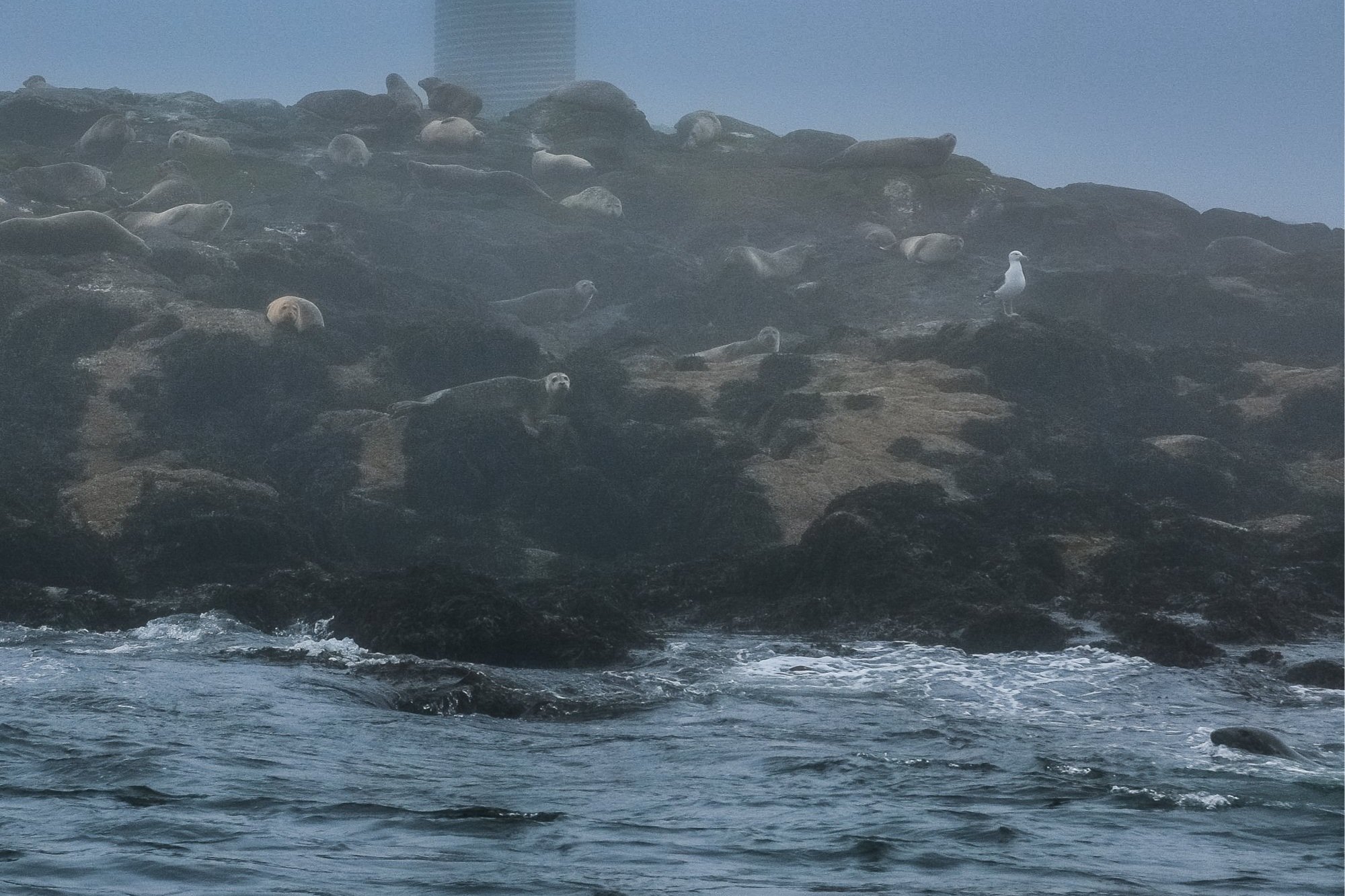The Puffin Tour at Machias Seal Island
UPDATED MARCH 17, 2025
The Puffin Tour
If seeing puffins close up is on your bucket list, book a half-day excursion to Machias Seal Island (MSI). Sea Watch Tours online reservation calendar will open for bookings beginning on March 17, 2025 at 10 am AST. Reserve your spot early. Tickets are limited. This is a popular tour and sells out quickly. Avid bird watchers, nature lovers, scientists, wildlife photographers, and filmmakers have been flocking to this wee island in the lower Bay of Fundy for almost two hundred years. The National Audubon Society’s namesake John James Audubon visited in 1833, and puffins from the island are featured in his paintings. Folks like me go, too, toting a little camera with a tiny lens, and a big sense of adventure because no other birding destination compares for close-range puffin observation and photography. If you love puffins, the puffin tour on Machias Seal Island is a must do.
Diverse Seabird Colony
Machias Seal Island (MSI) lies between the Bay of Fundy and the Gulf of Maine. It supports the most diverse seabird colony in the Canadian Maritimes and the broader Gulf of Maine ecosystem. Thousands of seabirds make their summer home on MSI during nesting season. The rest of the year they are at sea. The Atlantic Laboratory for Avian Research (ALAR) counted 8600 pairs of Atlantic Puffin, 3500 pairs of Razorbill, and 800 pairs of Common Murre on MSI in 2023 and estimated <200 pairs of Arctic Tern, <100 pairs of Common Tern, and <100 pairs of Leach’s Storm-petrel. There is one pair of Northern Gannet that also frequent the island. Over the years,100 different sea and land bird species have been spotted on MSI. All of this to say, when you visit MSI, expect to see lots of Atlantic Puffins, thousands of them, and a lot of other fascinating seabirds. You might even catch a glimpse of the occasional migrant land bird that rests here, too. What you can be guaranteed though, is an experience like no other.
A Golden Ticket
There are two tour boats that have access to MSI, one from Grand Manan, New Brunswick, Canada and one from Cutler, Maine, USA. I visited the 20-acre island with Sea Watch Tours out of Seal Cove, Grand Manan. If you live south of the border, the American counterpart is Bold Coast Charter Co. Each tour boat company is allowed to bring just 15 guests onto MSI. for one hour, once a day, six days a week, during the short nesting season. Typically the puffin tours run late June to the end of July, and these precious seats fill up quickly and sell out fast. Then even if you garner a coveted ticket, inclement weather can cancel your trip or rough seas may make landing on MSI’s narrow slip and rocky shore impossible. However, if you are one of the lucky ones that make it ashore and into a viewing blind, you are in for an unforgettable experience. Spending time so close to puffins is an extraordinary privilege. No other east coast bird sanctuary offers this unique opportunity for the general public. It is truly a golden ticket to witness the most important puffin colony south of Newfoundland.
Photo courtesy of Peter Wilcox, Sea Watch Tours
Sea Watch Tours
Sea Watch Tours operated as a family business for the Wilcox family since 1963. Then, in January, 2023, the baton was passed to Alec and Victoria Ingalls, after two years of working alongside former owners, Peter & Kenda Wilcox. I recently spoke with Peter, who ran Sea Watch Tours for 38 years, 10 of which began with his dad, Preston Wilcox. The last 28 years saw Peter step up as Captain and Durlin Ingersoll join the team as his First Mate. Peter fondly recalled his first trip to MSI as a 6-year old boy when his dad first began visiting. Preston fell into doing island tours when he was first awarded the contract to take the mail and groceries to the lighthouse keepers in 1961. In the beginning, he would take local curiosity seekers for free, then in 1963 he started charging $3 each. At that time it was just known as Preston’s Tours. The Sea Watch title came in 1979. I also corresponded with Victoria, as Alec was deep into lobster fishing season. She shared they have always been fascinated with the MSI seabirds, and as the new owners of Sea Watch Tours, they are passionate about sharing what they know while safely transporting their patrons to and from the island.
Photo courtesy of Susan Hill
Puffin Tour Trips
It was Captain Alec and his First Mate Glen Brown who greeted us on July 5, 2023 as our Sea Watch Tours guides for the 5 1/2 hour puffin tour. Susan Hill, Executive Director of Charlotte Coastal Region, and I arrived on Grand Manan the day before, which is a requirement. It was our second attempt, as our June tour date had been cancelled due to weather. Fortunately, Susan and I secured two other spots, and were thrilled this one was a go. We checked in at 7 am at Seal Cove Harbour Wharf and boarded the Day’s Catch, a fishing boat that also doubles as a tour boat in the summer. Passenger seating replaces where lobster traps sat months earlier. After boarding, I noticed most passengers were carrying very expensive cameras with mega-zoom lenses. Susan, who is a part-time professional photographer, noticed too, and lamented she had not brought her biggest lens. I turned and saw Penelope and Quentin, filmmakers from France who were also travelling with us, taking stock of their videography equipment. I pulled my Canon EOS Rebel TS6 with a Tamron 17-50 mm lens closer to me, and sheepishly smiled. However, I was more than happy with my small but mighty camera when I uploaded my photos to my laptop at the end of the day. A big camera is not necessary. A good waterproof jacket is though, as well as layers of warm clothing, and maybe a Gravol, if you are prone to sea sickness. Glen says most people laugh when he introduces the motion-sickness bag but he said there are very few days when somebody on board won’t need one. So be prepared. Our day was s a good one though, as no one was ill.
Atlantic Puffins
We settled in aboard the 45-foot vessel, and after a few general safety instructions, we were on our way to MSI, 19 km away. Some passengers were return visitors to MSI, but most were first timers, like us. One shared this was his eighth year’s attempt to get an online reservation. Susan and I realized our one-time cancellation was just a slight glitch, and we were elated to be on our way to our bucket-list adventure. Our hour-long trip was foggy, and a tad rainy. I walked around the deck hopeful for a marine animal or seabird sighting, but gave up and returned to my seat to huddle for warmth and chat with other passengers. Glen shared general information and sanctuary guidelines. Then before you knew it, the tiny, teardrop-shaped, treeless, rocky island appeared before us, as did the puffins. Passengers scrambled to their feet. Those unmistakeable colourful beaks, chubby bodies, and the cutest orange feet, were noisily flapping by, some on their way out to sea, and some heading back in with mouths laden with tiny fish. We saw other seabirds, too, but it was the puffins that commanded our attention. Susan and I exchanged ear-to-ear grins.
Photo courtesy of Susan Hill
Photo courtesy of Susan Hill
Machias Seal Island
The Day’s Catch anchored and we were shuttled ashore in small groups aboard Little Catch, a16-foot outboard motorized skiff. Landing on MSI can be tricky, and is is at your own risk. You should be sure-footed to take this on. The slip is narrow and covered with seaweed, so it can be slippery. Shoes with good grips are advised. I wore sneakers and was fine, others wore boots. You are supported in and out of the skiff, then you are directed to make your way up to the top of the slip. We were awestruck at the scene before us. Thousands of seabirds were sitting or standing on the rocks, floating in the water, and flying all around us. If “The Birds” movie by Alfred Hitchcock unsettles you, MSI is not for you. Our senses were assaulted with a pungent “au de bird poop & raw fish” stench, and the noise from thousands of seabirds was deafening, but no one was complaining. We were here! We made it! The excitement was palpable. The cameras were out and clicking away. We removed our lifejackets and were handed metre-long white poles with colourful stripes at the top. Firm directives were given to hold them high above our heads, and to follow Sea Watch Tours team members to our blinds. We were warned to walk quickly, and not to stop to take photographs. We were now on a protected migratory bird sanctuary. Our presence was stressful, especially to the terns that nest in the grass next to the boardwalk, and for the safety of them, (and I soon discovered us, too), we had to be quick, move as a group, and never lower our sticks. They were our protection from the angry terns that relentlessly swooped at us. Their high-pitched shrieks kept us moving. The sticks deter them from getting too close, as without them, many visitors would receive a much more aggressive warning.
Photo courtesy of Susan Hill
Photo courtesy of Susan Hill
Photo courtesy of Susan Hill
Arctic Terns
My heart went out to those frantic dive-bombing terns and especially to the sole tern that stood her ground atop her nest just feet away from the boardwalk. She sacrificed herself as she was too terrified to expose her nest’s precious cargo. In that moment, I wondered if tours to the island were a good thing or not. I felt such guilt for putting these little birds in such stress, but I learned later these tern nests are among the most successful ones on the island. Gulls, are a much greater predator, as they prefer snatching eggs and hatchlings from quieter, more exposed nests on the island. Lobster fishing off of MSI first drew gulls to the region, then some got a taste for what awaited them in tern nests. The once 2000 pair of Arctic Tern here, now number fewer than 200. ALAR researchers and wildlife managers have tried every non-lethal way to save these colonies from the gulls, but nothing seems to work. These tenacious terns are tough and migrate further than any other seabird. They travel from their breeding grounds in the Arctic to their wintering grounds in the Antarctic, but they are no match for the gulls that steal their eggs and prey on their young. To see their numbers decimated, as the former largest North American Colony, is devastating but there continues to be much debate over lethal control of the gull population. Troublesome gulls are sometimes shot or pin holes are put in eggs on their nests on nearby Gull Rock. Public education is key, so that gull predators can be managed, but this whole scene, is not for the faint of heart.
Photo courtesy of Susan Hill
Bird Sanctuary Viewing Blinds
We continued along the boardwalk, observing flags here and there indicating tern nests, then as the terrain changed, spray-painted rocks marked where other seabird burrow nests lay hidden below. Ken Ingersoll, one of the lighthouse keepers, greeted us with a wave, as we began disappearing into our enclosed wooden blinds. Our group took a left turn just past the lighthouse, and Penelope & Quentin, and Susan & I entered our blind. Glen said to make the most of our time and he would be back for us in an hour. He added, if anyone developed claustrophobia, you should simply exit the blind, raise the safety stick, and walk swiftly back to the beginning of the boardwalk and await for Sea Watch Tours team support. We nodded, then spread out, as much as one could in a 3’ x 7’ enclosure. We began to lift the sliding wooden window hatches to get our first glimpse outside. Once opened, a hatch is big enough for your camera lens to poke through but not your head. We settled in and began to observe, photograph and video the seabirds outside, all seemingly unaware or undisturbed by our presence, and some, to our delight, were just 3-6 feet away. And so began the quickest 60 minutes of our lives.
Feathered Friends
My best advice is to focus on one bird at a time. Capture as many photographs and video as you want, but also lower the camera and just be present. Our blind gave us close-range views of Atlantic Puffins, Razorbills, and the occasional Common Murre. Puffins are often referred to as the “clowns of the sea,” for their brilliantly-coloured beaks, but I also think they are far more animated and expressive than the other seabirds. They were fascinating to observe and the most fun to photograph. I had one tiny one in particular that seemed to take great pleasure in posing for me. I focused mainly on the puffins, but one unexpected highlight was watching a Razorbill lure its puffling out of its nest to introduce it to the world. The puffling clumsily tried to maneuver the rocks, slipping and stumbling along, and the father patiently led the way, doubling back when needed, all the while stopping and modelling behaviours for its puffling to emulate. It was endearing and an honour to watch this interaction. Another special memory was when a group of seabirds landed on our roof top and began to walk around. We had miniature tap dancers mere inches from our heads. We all stopped in silence and enjoyed this magical moment. When the knock at the door came an hour later, we quietly sighed in unison. So soon? But Island sanctuary regulations limits the time actually spent ashore to protect the nesting seabirds from excessive disturbance. I am glad someone is looking out for these beautiful creatures. Our feathered friends deserve all the protection bestowed on them. One hour gave us a lifetime of memories and we were all very grateful. It was a day we will not soon forget.
Photo courtesy of Peter Wilcox, Sea Watch Tours
Skiff Tour
We were all still on a high when we climbed back aboard Day’s Catch. Fifteen people in total enjoyed an hour on MSI and five others had signed up for a skiff tour aboard Little Catch, which motors around the island during that same hour. Those guests were equally bursting with excitement and had plenty of photographs to share. This is another option available to those that were not able to secure a ticket for an on-island tour. It is the next best thing. The same number of birds can be seen from the skiff, and sometimes the puffins are closer depending on sea conditions. Guests booked for the skiff tour are also automatically on the waiting list for any available shore spots. On days when the Captain feels slip landings are not safely possible on MSI, Sea Watch Tours offers the same experience to their guests but aboard The Days Catch. And always, if a puffin tour participant is not comfortable going ashore, staying aboard the tour vessel is always an option.
Photo courtesy of Debbie Bath
North Rock
We made a pit stop at a nearby seal colony gathered on North Rock next. A pea soup fog had settled in so the photo opportunities were limited. Often upwards of 200 seals can be viewed here. On our final trip back to Grand Manan, I buzzed around the boat to glean more about everyone’s day. One blind was treated to an extremely rare close up view of a Northern Gannet. Tired, with full hearts and full camera cards, the boat fell into a lull as we pulled out our packed snacks brought along for sustenance. Coffee and hot chocolate were available in the heated cabin, and Captain Alec and First Mate Glen delivered us safely back to Seal Cove. We thanked them for our once-in-a-lifetime experience and left the wharf with visions of puffins still in our heads.
Photo courtesy of Susan Hill
Photo courtesy of Susan Hill
Photo courtesy of Ken Ingersoll
Machias Seal Island Lighthouse Keeper
Once back home, I researched Machias Seal Island and discovered it is a designated migratory bird sanctuary for both the United States and Canadian Wildlife Services. The island, and the rich fishing waters surrounding are in a grey zone that has been in dispute since the War of 1812, with Great Britain (now Canada) and the US each laying claim. However, the Canadian Coast Guard owns and has been operating the lighthouse on the island for over 100 years. Two Canadian keepers are always on the island maintaining it year-round, with their stays being rotated every 28 days with other keepers. I had the honour of chatting with Ken Ingersoll, who after enjoying 15 years as the lighthouse keeper for Swallowtail and Long Eddy Point lighthouses on Grand Manan, recently enjoyed his first stint as the MSI watch on three different months in 2023. Ken spoke about his MSI lighthouse keeper role, and his experience living 24/7 with the seabirds that nest or rest there. “I love it. It’s a dream come true. I’ve been a naturalist and worked with the Grand Manan Whale and Seabird Research Station since 1983, so when it comes to birds and wildlife, it’s in my wheelhouse. To be a lighthouse keeper for the Canadian Coastguard is also an honour. Plus, I get a nice helicopter ride out of it.”
Photo courtesy of Ken Ingersoll
Photo courtesy of Ken Ingersoll
Photo courtesy of Ken Ingersoll
Living on Machias Seal Island
Ken’s first deployment was in late Jaunary 2023. It was cold but breathtakingly beautiful and he was immediately smitten with the little purple sandpipers that became company for him on his daily walks. “The little guys would walk right along with me.” Even after one particularly strong gale with gusts reaching 80 knots (148 km/h), they were there the next day when he checked the lighthouse exterior for damage. He was gobsmacked they survived it. “They’re so tough. It’s incredible.” March was his next assignment, and when Ken arrived by helicopter, he noticed what he thought were a lot of ducks floating in the water about a 1/3 of a mile out from the island. Ralph Eldridge, the 50-year veteran MSI lighthouse keeper, with whom he was sharing duties, enlightened Ken that the Razorbill Auks and Common Murres had arrived. Ralph told Ken to wait for a just little bit and he would see them come ashore - all at once. Then sure enough… it happened. “Every day you would see them flying and they’d get a little closer to the island, then a little closer, and a little closer. Then they’d back off, but Ken said to just keep watching them. Then when they flew over the island that meant they were getting ready to come in and roost. Ralph had seen this for years. He’s an avid birder, he knows his stuff. So, I’m continually listening to him and watching every day, and then they hit, probably around the 20th of March, and it was amazing, over 4,000 birds all landed at once. It was actually quite noisy, too. I was astounded! I had never seen anything like it. So, that was really, really cool. I took a lot of photographs and two days later, they all left and Ralph said, “Oh no, don’t worry, in another day or two and they’ll all be back,” and sure enough, back they came. There’s also one pair of Gannets that nest on the island, just the one pair.” Ken certainly is in his happy place living on Machias Seal Island and I was spellbound with his stories.
Photo courtesy of Ken Ingersoll
Photo courtesy of Ken Ingersoll
Photo courtesy of Ken Ingersoll
The Island Comes Alive
Ken’s next deployment was near the end of June - first of July. “I landed, and opened the door of the helicopter and all I could smell was bird dung. There were over 13,000 nesting pairs of birds: Puffins, Razorbills, Common Murres, and Arctic Terns. The terns were like little fighter jets zipping around diving at you and squawking. The island really comes alive then.” I was curious what the noise was like at night, and Ken shared he loved it. “I like to open my window, and listen to the different sounds of the chicks and the adults. You hear them all night long but not loud like you do in the daytime.” Four researchers come to the island over the summer for 3-4 months as well, and Ken said it makes for a total different atmosphere. “You’re used it just being two of you, and you’d be having lunch or be on the radio, and you’d catch someone else out of the corner of your eye, and it reminds you you’re not alone.” During the nesting season, a group of ALAR researchers move into the other residence near the lighthouse. They mark nesting areas, count, band, and record bird specifies activity. This group is responsible for the data I first shared at the onset of this article. They gather vital statistics. “I spent some time in the blinds with them,” Ken continued, “And I helped with some of their observations. I like to participate as much as I can. The research they do is very important for the survival of these birds.” I asked Ken about the tern and gull situation. “Often public opinion, although important, is an emotional response, not a logical response, and sometimes you need to do things for the better good. It’s not my area of expertise, but I think Dr. Tony Diamond and the researchers have a pretty good handle on what’s going on and they are very good at calling what is right and wrong.” Public education does seems key for everyone to understand more, and as for the visitors coming ashore, Ken thinks the payoff is worth it. “The only time you’re stressing the seabirds is the little time you walk from Point A to Point B. The majority of the time you’re in the blinds. I watch them after tours leave and they settle back in. The researchers cause more stress, when they do their measuring, but it’s all vital work. And the birds also settle down after that, too.” MSI is a fascinating place to work. Ken gets to see so much and he has his fingers crossed for a full-time position coming up in 2024. “It’s quite an experience. I enjoy it a lot. I get pretty excited when they call, and it’s time for me to go. I am very fortunate. I’ll do three months again this year, unless I get the full-time job, but someone else might get it, too.” I’ve got my fingers crossed for Ken. The best part of his job, he says, is the solitude and the quiet. “I spend a lot of time high up in the tower. I sit in the lantern room and read and watch. And when I return on January 28th this year, I expect to see my little buddies, the purple sandpipers again.”
Puffin Tour Tickets
Come to Machias Seal Island to witness the spectacular seabird nesting colonies of Atlantic puffins, Razorbills, Common Murres, and Arctic & Common Terns, among others. The experience will leave you awestruck. My curiosity over puffins brought me here. These little clowns will steal your heart, but you will soon fall in love with many other seabirds that call Machias Seal Island their summer home, too. I hope to return again, to meet more of my feathered friends up close and personal and to learn more about the important work that is being done on this tiny island. Sea Watch Tours online reservation calendar will open for bookings beginning on March 17, 2025 at 10 am AST. Reserve your spot early. Tickets are limited. This is a popular tour and sells out quickly. Hope to see you there.
Grand Manan Island
Grand Manan Island welcomes you with open arms to its rugged, storm-beaten, yet peaceful haven. It is the island that is too good to be true. The waters around Grand Manan are a haven for whales, porpoises, seals, and seabirds. Let it share its unspoiled scenic vistas and hidden secrets. I highly recommend staying for a week to take it all in. Click on the link below for more information.
This post was sponsored by Charlotte Coastal Region Tourism; however, all thoughts and opinions are my own. Follow Maritimes Maven on FaceBook, Instagram, Pinterest, LinkedIn & Threads. Subscribe to be the first to receive my latest articles. Share articles you love with your social media community so they, too, will discover, There’s No Place Like Home!

